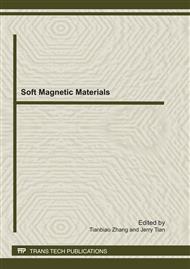[1]
N.A. Hill, Journal of Physical Chemistry B 104, 6694 (2000).
Google Scholar
[2]
H. Schmid, Ferroelectrics 162, 317 (1994).
Google Scholar
[3]
N.D. M. W. Erenstein, and J. F. Scott, Nature(London) 442, 759 (2006).
Google Scholar
[4]
S. -W. Cheong and M. Mostovoy, Nat. Mater. 6, 13 (2007).
Google Scholar
[5]
J.P. Velev, C. -G. Duan, J.D. Burton, A. Smogunov, M.K. Niranjan, E. Tosatti, S.S. Jaswal, and E.Y. Tsymbal, Physical Review Letters 9, 427 (2009).
DOI: 10.1021/nl803318d
Google Scholar
[6]
C. -G. Duan, S.S. Jaswal, and E.Y. Tsymbal, Physical Review Letters 97, 047201 (2006).
Google Scholar
[7]
T. Kimura, T. Goto, H. Shintani, K. Ishizaka, T. Arima, and Y. Tokura, Nature (London) 426, 55 (2003).
DOI: 10.1038/nature02018
Google Scholar
[8]
T. Lottermoser, T. Lonkai, U. Amann, D. Hohlwein, J. Ihringer, and M. Fiebig, Nature (London) 430, 541 (2004).
DOI: 10.1038/nature02728
Google Scholar
[9]
C.W. Nan, M.I. Bichurin, S.X. Dong, D. Viehland, and G. Srinivasan, Joural of Applied Physics 103, 031101 (2008).
Google Scholar
[10]
A.A. Belik and E. Takayama-Muromachi, Journal of Physics: Conference Series, 012035 (4 pp. ) (2009).
Google Scholar
[11]
P. Ravindran, R. Vidya, A. Kjekshus, and H. Fjellvag, Physical Review B 74, 224412 (2006).
Google Scholar
[12]
A.G. Gavriliuk, V.V. Struzhkin, I.S. Lyubutin, S.G. Ovchinnikov, M.Y. Hu, and P. Chow, Phys. Rev. 77, 155112 (2008).
Google Scholar
[13]
N.A. Hill, P. Battig, and C. Daul, Journal Physics Chem. B 106, 3383 (2002).
Google Scholar
[14]
A.A. Belik, S. Iikubo, K. Kodama, N. Igawa, S. Shamoto, and E. Takayama-Muromachi, Chem. Mater. 20, 3765 (2008).
DOI: 10.1021/cm800375d
Google Scholar
[15]
A.A. Belik, Y. Hitoshi, H. Naohisa, O. Yasuo, and T. -M. Eiji, Inorg. Chem. 48, 1000 (2009).
Google Scholar
[16]
G. Kresse and D. Joubert, Physical Review B 59, 1758 (1999).
Google Scholar
[17]
G. Kresse and J. Furthmuller, Comput. Mater. Sci. 6, 15 (1996).
Google Scholar
[18]
J. Perdew, S. Burke, and M. Ernzerhof, Phys. Rev. Lett. 77, 3865 (1996).
Google Scholar
[19]
J. P. Perdew and Y. Wang, Physical Review B 45, 13244 (1992).
Google Scholar
[20]
A. Lichtenstein, V. Anisimov, and J. Zaanen, Physical Review B 52, 5467 (1995).
Google Scholar
[21]
V. Anisimov, F. Aryasetiawan, and A. Lichtenstein, J. Phys. Condens. Matter 9, 767 (1997).
Google Scholar
[22]
A. Petukhov, I. Mazin, L. Chioncel, and A. Lichtenstein, Physical Review B 67, 153106 (2003).
Google Scholar
[23]
P. Baetting, C. Ederer, and N. A. Spaldin, Physical Review B 72, 214205 (2005).
Google Scholar
[24]
N. Lampis, C. Franchini, G. Satta, A. Geddo-Lehmann, and S. Massidda, Physical Review B 69, 064412 (2004).
Google Scholar
[25]
J. S. Smart, Phys. Chem. Soilds 11, 97 (1959).
Google Scholar
[26]
X. -Y. Chen, R. -Y. Tian, J. -M. Wu, and Y. -J. Zhao, submitted.
Google Scholar


